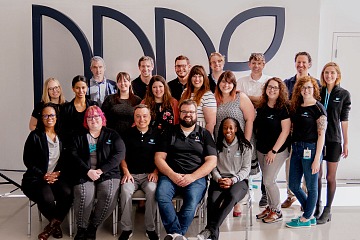Hiring, Recruiting, Recruiting Strategies, Retention Strategies, Talent Acquisition
Recruiting strategies that reflect the changes facing hiring managers today are critical to any talent management strategy. From rethinking culture fit to checking for bias, here’s how to ensure top talent will want to come to you.
Long gone are the days of posting on a job board and waiting for candidates to come to you. Today, the hunt for top talent is fierce, candidates have more leverage, and successful employee recruitment is a proactive two-way effort. Not only are employers seeking the right talent, but talent is seeking the right employer.
That means more than just competitive salaries and benefits. It also means growth opportunities, DEIB efforts and work–life balance, as well as a healthy, supportive culture. In fact, in our study of the U.S. workforce, a whopping 98% of respondents said great culture is important in their next job search.
How do you recruit and retain employees when the hunt for talent is growing ever more competitive?
These 11 recruiting strategies reflect the changes facing hiring managers today. We recommend making these tactics part of a broader, more long-term talent acquisition strategy.
From rethinking culture fit to checking for bias, here’s how to ensure top talent will want to come to you.
1. Understand your EVP
An employee value proposition (EVP) is what an employer offers to employees, both monetary and non-monetary, in exchange for their work. That includes salary, health benefits, growth opportunities, training and personal development, and perks such as remote work or flexible hours.
However, a successful EVP is more than just a list of benefits. It’s also your company’s overall culture — what distinguishes you from other employers out there? Why should an employee pick your organization over a competitor’s?
“I think a good strategy is to write out your EVP and then strike your organization’s name from that write-up,” says Seth Willis, senior culture coach with Great Place To Work®. “Would you be able to tell it’s your organization, based on the values, based on what you consider to be those differentiators?”
2. Recruit for culture add, not just culture fit
We often hear of culture fit — does a candidate “fit” into a company’s culture and existing workforce? But focusing too heavily on fit not only limits your talent pool, it also risks homogenizing your entire workforce. Instead, aim for “culture add.”
Diverse and inclusive teams are innovation engines, says Frans Johansson, founder and CEO of The Medici Group. His team has found through their work with thousands of companies that, across industries, organizations that seek out diverse views are more innovative, more creative, and better at making decisions.
Within your own workforce, assess what you already have and what your team is missing. Then, consider every aspect of a candidate, from their lived experiences to their people skills, to see what they can bring to the table.
3. Shift from education-based to skills-based recruiting strategies
Just as culture fit is an outdated employee recruitment strategy, so too is education-based recruiting, especially as workforces become more globalized. Degrees vary from country to country, and within the U.S., the cost of post-secondary education means underprivileged candidates are often left out of the running.
While of course there are some roles that require specific degrees or credentials, for many positions hands-on experience, ability, and passion are just as strong an indicator (if not stronger) of a candidate’s ability to perform.
“It’s a huge way to open up your talent pool,” says Seth. “Look for folks you are an atypical applicant or have transferrable skills, who you can train or who can adapt — rather than somebody who might be a cookie cutter fit from a technical standpoint.”
A recruitment example of this is Bitwise Industries, which aims for more diverse hiring practices by removing degree requirements when they are not necessary and offering a training program that helps promising, yet overlooked, talent break into tech.
As another recruitment example, Nationwide Mortgage Bankers takes this one step further with a rather unconventional hiring strategy: they hire candidates who fit their core values, even if there isn’t a specific position created for them yet.
4. Make the most of employer awards
“Award-winning” is a phrase that always gets attention, but not all awards are created equal. Many employer awards don't reflect ongoing employee feedback, omit critical measures of employee retention, and reflect employee satisfaction rather than employee experience.
For job seekers, awards that are based on confidential reviews by current employees are far more valuable than awards voted on by a panel of experts or former employees, for example.
That’s why Great Place To Work Certification™ relies on our own rigorous Trust Model, which puts the employee and the “here and now” at the center of our confidential Trust Index™ Survey. This methodology measures key indicators of a high-trust workplace culture including fairness, respect, leadership credibility, workplace pride, and camaraderie.
Achieving Certification is a step towards making one of our Best Workplaces™ Lists, which in turn is an excellent way to get your company’s name in front of top talent.
5. Check your job descriptions
Just as we expect candidates to put effort into their job application, we should put equal effort into our job descriptions. Don’t just set out what you’re looking for, but include what you can offer and why someone would want to work with you.
Job descriptions that are packed with corporate jargon or that focus too much on what the company does, rather than what the employee will do, won’t stand out against competitors. Not only that, but your job description could have implicit bias in its language or requirements.
There are various software programs through which you can run job descriptions (as well as other content) to flag concerns like gender-coded words, age and racial bias, and ease of reading.
6. Treat your candidates like customers
Marketing and recruiting strategies go hand-in-hand. The time, effort, and consideration that goes into every piece of customer marketing material should be equally applied to how you communicate with employees — past, present, and future.
“I look at everything through the lens of ‘I’m a person applying for this job’ when I’m on our website,” says Stephanie Oribhabor, director of employee experience at Great Place To Work. “What am I feeling when I’m reading this job description? What words are they using? What associations do these words have to my own biases or my own ways of thinking?”
She adds that this applies to more than just the job description. It’s the automated email a candidate gets once they submit their application; it’s how an interview is conducted and how the job offer is presented. It could be how you display that you’ve earned Great Place To Work Certification.
Consider your employer brand and how it’s being presented at every stage of the employee recruitment process.
7. Remember that first impressions matter
First impressions no longer start at the first interview. Instead, whether it’s from your company’s Glassdoor reviews, Certified profile, or LinkedIn profile, candidates will have formed an opinion of your workplace before they’ve even applied.
“We’ve seen a big shift in the speed at which people are able to (a) find out information about your workplace and (b) figure out very quickly before even talking to you if they want to work there,” says Stephanie.
If you’re seeking top talent, you’ll need to ensure that those first impressions reflect what candidates seek. Today, job seekers have more leverage than in the past, and their expectations of employers are firm. Our research has shown that millennials, more than previous generations, want purpose in their work, while Gen Z want psychologically and emotionally healthy workplaces.
“Before, it was, ‘I don’t care; I just want a job,’” says Stephanie. “And now, it’s not only ‘I want a job,’ it’s ‘I want a place that aligns with my own internal values.’”
8. Keep it two-way
When it comes to how to recruit employees, it’s long been viewed with a one-way focus: finding the right candidate to fit your workplace, rather than ensuring your workplace is the right fit for a candidate.
Will the candidate enjoy working with you? Do they see opportunities for growth with you? Are you able to meet their needs — financially, professionally, and emotionally?
Dayna Blank, senior vice president of human resources with Playa Hotels & Resorts, says that hospitality recruitment in particular rarely includes asking candidates what they want in a workplace. As such, Dayna’s team conducts two-way interviews that openly discuss whether the candidate will feel engaged with their day-to-day.
9. Tap into your existing workforce
When you’re looking to bring on new talent, it can be easy to focus too much externally — and ignore your biggest internal resource. Employee referrals are a much-overlooked aspect of the recruiting process, says Stephanie.
“They’re your biggest ambassadors because they’re the ones out there having conversations with colleagues and friends and talking on social media,” she explains.
Even if you’re not running a specific referral incentive program, simply asking your existing employees why they work for you can provide insight into what you have to offer new hires. These “stay interviews” are becoming more common, say Stephanie and Seth, and can be tied into milestones like anniversaries or raises/promotions.
You could even hire back “boomerang employees,” who may have left to try to something new or due to restructures. If the departure was handled respectfully and with empathy, those past employees may be eager and willing to return once circumstances are turned around, suggests Stephanie.
10. Recognize how the workplace has changed
Hybrid and remote work, once a perk reserved almost exclusively for freelancers and upper management, has now become the norm for all employees. And as we settle into this new normal, companies need to adapt with new recruiting strategies.
“Before, it was that you lived your life on the weekends,” says Stephanie. “Companies have to figure out a way to be more flexible — maybe that means less time in an office, maybe you go to the office once a week. Job seekers are looking for flexibility because there is life to be lived outside of work.”
Stephanie adds that it’s more than just offering flex time but also recognizing the reasoning behind that flex time. Maybe an employee loves to travel. Maybe they’re a parent. Maybe they like to take art classes on Wednesdays at 12. It’s acknowledging a candidate’s whole self and encouraging them to bring that whole self into work once they’re hired.
“Work has taken on such a human approach,” she says. “For the first time, you’re seeing your CEO work from home in a polo shirt with his dog on his lap. We’re all figuring out what work-life balance really is and what that means to a workforce.”
11. Remember recruitment vs. retention
Hiring a new employee can feel a lot like dating. You’re meeting with various people, looking for the “right” one to commit to.
That makes retention the long-term relationship. It’s one thing to charm an employee in the early days, but it’s another thing to keep that commitment going beyond the honeymoon phase.
That’s why your recruiting strategies should mirror your strategies for retention. While how to recruit and how to retain employees aren’t the same thing, focusing on one without the other will leave you in a recruiting loop that can feel an awful lot like the movie Groundhog Day.
“Recruitment is all the things you’re going to do to get people in the door,” says Seth. “But retention is everything you do to keep people inside the organization. All those things you communicated in the recruitment phase really show.”
Make Certification part of your recruiting strategy
Does your employer brand stand out from the competition? Prove you’re an employer of choice and attract top talent by earning Great Place To Work Certification.














